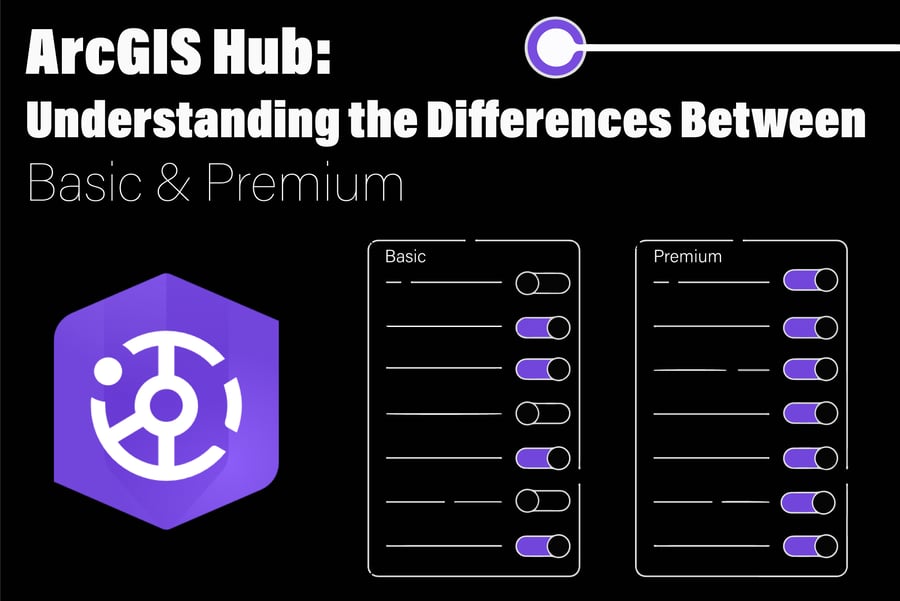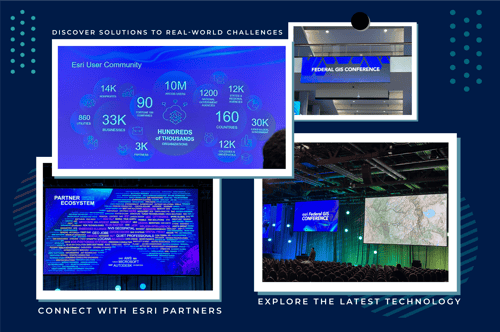ArcGIS Hub: Understanding the Differences Between Basic and Premium

Hello, fellow GIS enthusiasts! Have you ever wanted to showcase your projects and data while also fostering community engagement? Whether you're unsure where to begin or which tools are the best fit, you've come to the right place. In this blog post, we’ll dive into Esri's ArcGIS Hub platform, highlighting the key differences between Hub Basic and Hub Premium. By the end of this quick read, you’ll have a clearer understanding of which product aligns best with your organization’s needs and how to effectively leverage these tools for your GIS initiatives.
Before we get into the details, let’s start with a high-level introduction to ArcGIS Hub. At its core, the platform is a community engagement tool that organizes people, data, and tools through information-driven initiatives. It aims to maximize data-sharing capabilities, collaboration, communication, and community engagement both internally and with external stakeholders. The key difference between Hub Basic and Hub Premium is the level of community engagement and collaboration offered by the product. So, let’s get into it…

Hub Basic
Included with ArcGIS Online subscriptions, Hub Basic is the foundational tier of the Hub platform. It allows organizations to create unlimited sites, which are easy-to-configure, customizable websites (no coding required!) that serve as the public face for organizations or specific projects. Sites are great for keeping everything organized in an easy-to-navigate place, including data, maps, and apps. To manage shared content, administrators can create groups to distinguish between data shared within the organization or publicly. These are ideal for organizations that want to present data and other resources by allowing users to view and access content, but do not have a need for extensive community involvement.
Hub Premium
Hub Premium builds on the capabilities of Hub Basic and introduces several advanced features geared towards public engagement. A separate license is required to access the capabilities of Hub Premium, with special pricing available for non-profits and customers with ArcGIS Enterprise Agreements.
Initial Set Up: The AGOL Hub Community Organization
When you obtain a Hub Premium license, you will be prompted to activate an account for your new ArcGIS Online (AGOL) Hub Community organization, which is different than your ArcGIS Online Employee organization. Think of the AGOL Employee Organization as the parent org, while the Hub Community organization is a separate instance of AGOL specifically for external community accounts used to allow easy public engagement and contribution. Administrators of the Hub Community organization can add and manage external community member accounts and content.
Creating Initiatives
Another difference you may notice is that within Hub Premium, you’ll be creating initiatives. Now you may wonder, What’s an initiative? Weren’t we creating sites in Hub Basic? Yes, but initiatives have different functionality than sites. Initiatives in Hub Premium embrace a broader range of tools for community engagement, project management, and tracking, which includes sites. By default, when an initiative is created in Hub Premium, it is automatically associated with a site that serves as the face of the initiative where you can share your story and display content, just like in Hub Basic.
But it doesn’t end there! Since initiatives are designed to provide a high level of interaction by allowing external members of the public to create accounts through your AGOL Hub Community org and actively participate and contribute to an initiative, there are more advanced features to target public engagement. In addition to having unlimited sites associated with your initiatives, there are also teams, events, calls to action, projects, and more components available to leverage, which we’ll explore next.
Embracing the Public with External Community Accounts
Hub Premium takes the concept of community engagement to a new level. With the addition of the Hub Community organization, members of the public can use a personal email address to create accounts in the Hub Community org, without needing to be associated with an existing AGOL organization – pretty neat, huh?! If desired, external members can follow public initiatives and create their own community account directly through your initiative’s site home page. Or, if the initiative is not public or administrators want more control over who creates external community accounts, Hub Community admins can create external accounts for community members through the Hub Community AGOL organization. These capabilities allow for easy management and tracking of internal and external members.
Additional Hub Premium Capabilities
Teams
Within an initiative, there are two types of teams, core and supporting, that behave similarly to groups, but are specific to an initiative. By default, an initiative has one core team that gives members edit access to the entire initiative, meaning they can edit the page and all other items as if they are the owner. Any number of supporting teams can be added to an initiative, and they can have either view or edit access. These teams offer great flexibility and the ability to organize both internal and external community accounts, ensuring users have appropriate access to initiative-related content.
Events
Events in Hub Premium are activities or gatherings that are tied to a specific initiative. You can create events to add to maps or calendar views, and community members can sign up or RSVP to these events. They can be used to engage with the community, gather feedback, share information, manage attendance, and track participation. Events can be anything from public meetings, workshops or trainings, volunteer opportunities, or virtual webinars.
Calls to Action
Calls to Actions are interactive, goal-oriented elements you can place on your initiative’s Hub site to help engage community members with clear prompts, often guiding a user to do anything from following your initiative, RSVP-ing to an event, filling out a survey, or joining a project. They’re meant to draw people to your initiative and really tap into community engagement.
Projects
Projects in Hub Premium provide a structured way to organize, track, and communicate progress for initiative goals, including milestones and Calls to Action. Hub Premium also offers project metrics that allow you to track performance, contributions, and impact.
Wrapping Up
Deciding between Hub Basic and Hub Premium depends on your organization's needs. If your focus is on basic data sharing and internal collaboration, Hub Basic may be sufficient. However, if you require more advanced community engagement tools and the ability to manage complex, engagement-focused initiatives, Hub Premium may be a better fit.
Here at dymaptic, we’re proud to have been awarded the Esri Hub Specialty; adding this specialty to our list of credentials shows our team’s expertise and comprehensive knowledge of ArcGIS Hub. If you need help with Hub, feel free to contact us – we’re here to assist you in making the most of this powerful platform.



